Whenever I cook rhubarb in my house we can’t help but sing an adapted version of Lady Gaga’s ‘Bad Romance’. “Rah rah rhu-bar-barb, ro mah ro-mah-mah”. You get the picture. Yet my rhubarb romance is far from a bad one and as a plant it’s certainly not a prima-donna performer. Once established, rhubarb should need little primping, a useful trait for the time-pressed gardener. I have noticed a fair number of abandoned allotment plots will have a rhubarb plant growing away happily in a corner. To me that’s a sign of an easy to grow plant and thus a banker for a productive patch.
I love rhubarb in both the normal ruby and green speckled state as well as the pale pink forced form. Recently it appears to have had a resurgence in popularity in sweet and savoury cooking; it’s been featured in many a sunday cooking supplement. It’s also a trendy flavouring in spirits and artisan gins.
However, as a mother of three, I am aware that some children dislike it intensely. In a world where the tart, fruity sweetness of the ‘Haribo Tangfastic’ rules supreme, rhubarb’s lack of appeal with youngsters surprises me. I am left thinking the problem is probably to do with the texture, as it can be fibrous. Forced rhubarb is not only sweeter, but also finer is texture so getting children to try the forced form may be a good start. Growing and forcing rhubarb is very easy and an investment for the long term.
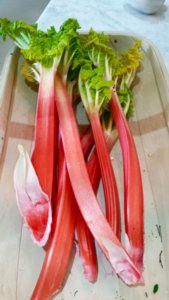
Forced rhubarb stalks
Buying rhubarb to grow at home
Rhubarb is best planted in late autumn or winter and you will find sections of the plants, known as crowns, bagged up and hanging on display in garden centres at these times of year. You can also buy them mail-order from reputable suppliers. If buying from a garden centre, it’s always worth taking a good look at it through the bag. You need to look for a bulbous, swelling leaf bud (greeny-pink in colour) and a firm rooted crown. These will indicate a plant in suspended animation, just waiting to be planted out so that it can get going
Of course a garden centre plant will have been split, packaged, transported and sat around waiting for you to buy it. If you order early, mail-order plants will be freshly dug, split and sent to you with minimal delay, usually in March. A mail-order collection that caught my eye was a three variety collection from D T Brown (www.dtbrownseends.co.uk). Containing three crowns, one each of early variety ‘Raspberry Red‘, sweet variety ‘Valentine‘ and later cropper ‘Red Champagne‘, the collection costs £12.95, reduced to £10.45 if two or more collections are ordered.
If you have a friend with a big rhubarb plant, you may be in for a freebie clump. A large crown of rhubarb, say four or five years old, could do with splitting to ensure continued productivity. Your friend could be persuaded to part with a chunk or two. I’ve heard this referred to as a ‘chip off the old block’ . Through my hedge I can spy one I gave to my neighbour a few years ago and I feel like a proud auntie every time I do.
Splitting is easy and just involves a bit of gumption if you’re a first timer. Dig one up and place on a fairly firm surface or lawn. Steel yourself before guiding a sharp spade swiftly through the crown. You’ll need to decide beforehand how many sections to split it into, so you can guide your cuts. This will take a bit of judgement but if you try and make sure that each part has at least two swelling leaf buds you should be fine. Done in late winter, the swellings will be easy to see but I have also split in autumn with success.
It is also possible to buy potted plants year-round but I would advise against planting these in summer if you think that you may neglect the watering. Planting a potted specimen in early spring or autumn may be wiser but of course at these times of year the slightly cheaper bare-rooted crowns are available anyway.
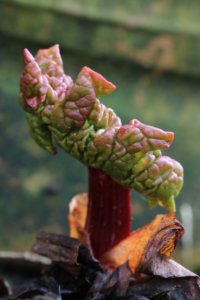
Emerging rhubarb leaf
Planting rhubarb
Rhubarb will do well in sun or partial shade but it’s worth thinking carefully about where to place it as once planted it really needs to be left alone to do it’s thing. Bear in mind it can become a large plant. The leaves can be a statuesque 60-80cm across on 60cm stems. They can flop over, so planting at the edge of a veggie patch is probably wisest.
I like big tropical-looking leaves and I think rhubarb leaves are attractive enough to have a place in a garden border amongst flowers and shrubs – useful if you haven’t got a veg patch. If you do this, just keep an eye out that the leaves aren’t impinging on those around them. If they are, give them a tug and take them indoors to eat. I call that bonus pruning.
Before planting it’s worth spending a bit of time getting the soil ready for the rhubarb by digging in some compost or manure. To plant your crown, dig a hole just deep enough for the top of the crown to be at the same level as the soil around it then pull some soil back around it and firm gently around the edge with your boot. Don’t be tempted to bury it deeply but try to leave the swelling leaves unburied to prevent rotting. Water in well and leave it to get going.
Rhubarb after-care
I consider rhubarb to be one of those plants that can sulk after planting. By this I really mean that it doesn’t look like it’s doing much for a year or two and you may worry it’s never going to. Just like a child having a sulk, it’s best left alone to sort itself out. Rhubarb has few things that can go wrong and the only threats are over watering – which causes rot, or drought through under-watering when newly planted.
Once a year, in early spring, I give my rhubarb a layer of manure. They can be hungry feeders and this will boost your crop. Don’t worry if you don’t get round to doing this. They’ll still crop, as evidenced by those abandoned allotment cast-aways I referred to earlier, but not as heavily. If you are forcing rhubarb then feeding is a must.
Rhubarb can be picked whenever it looks ripe (long stems, dark red in colour, streaked green with fully-unfurled leaves) until around august, when it’s best to leave it to recover for next year. To harvest, just reach down the stem towards the base and give it a sharp tug upwards so it comes away. Never take all the stems from a plant, but leave some to continue to feed the plant. It’s best not to cut the stems with a knife as the remaining part will need to rot back, which isn’t ideal.
I take my stalks straight to my compost bin and hack the large leaves off with a sharp knife. These leaves do contain poisonous oxalic acid but it won’t cause any harm in your compost. Check your plant every now and then for flower stalks as you will want to remove these to prevent the plant diverting it’s attention to flower and seed production. The photo below shows an emerging flower to the right of the terracotta forcer. They start as a green ball and you will be able to see the white flowers developing within the ball.
Rhubarb is one of the first plants to collapse in autumn. The leaves flop down and go black. Once this happens, just pull the leaves away gently and compost them, leaving the crown alone for the winter.
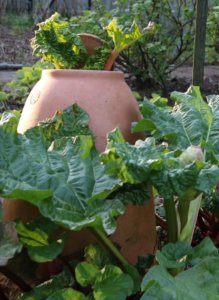
Forced rhubarb peeking out of a forcer. Rhubarb flower developing to the right.
Forcing rhubarb
Just as it’s name suggests, the process of forcing rhubarb involves getting it to grow earlier and more quickly than it would normally want to do. By shutting out light, and enclosing to increase the ambient temperature, the stems grow tall in search of light. The lack of light also reduces the oxalic acid in the stems. Oxalic acid gives rhubarb it’s sour taste so forced rhubarb is sweeter than when left to it’s own devices. The result is pale pink, long, tender stems, with small leaves and a sweet, delicate flavour.
Commercially, forcing is done in warm, dark sheds, with the UK’s famed West Yorkshire ‘Rhubarb Triangle’ producing tonnes of delicious, sweet, candy pink stems from January. At home, forcing can be done using a special terracotta forcer. My local independent garden centre sells these for just £30 (www.southheathgardencentre) but some cost approaching £100. I have also found victorian or ‘antique’ forcers running into the hunfreds and even thousands. Remember these forcers are terracotta and will split and shatter if left out all winter in the damp and frost. In an ideal world you would keep yours somewhere dry and frost free over the deep winter and only put into place in late winter when the crowns start to swell.
The forcers are attractive additions to a veg patch and have a little lid so that you can take a peek in spring to see how your rhubarb is doing. If you don’t want to buy a forcer, anything that can be placed over the crown to shut out light will work. I use an old chimney pot with a saucer on top, or you could use an old bin or bucket.
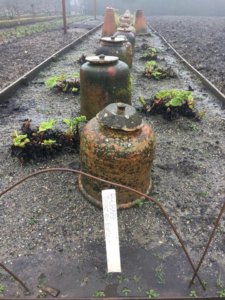
Rhubarb forcing rotation at the Lost Gardens of Heligan, Cornwall – Photo credit Claire Aston
Just like an olympic sprinter, the rapid pace required by forced rhubarb will exhaust it. It’s important not to try to force a newly planted crown – best wait a couple of years – or to force the same plant every year. If you want to force rhubarb, and you have the room, it may be worth having two or three crowns so they can be forced in rotation. The picture above, taken at the Lost Gardens of Heligan, www.heligan.com shows rows of rhubarb forced in turn, year by year.
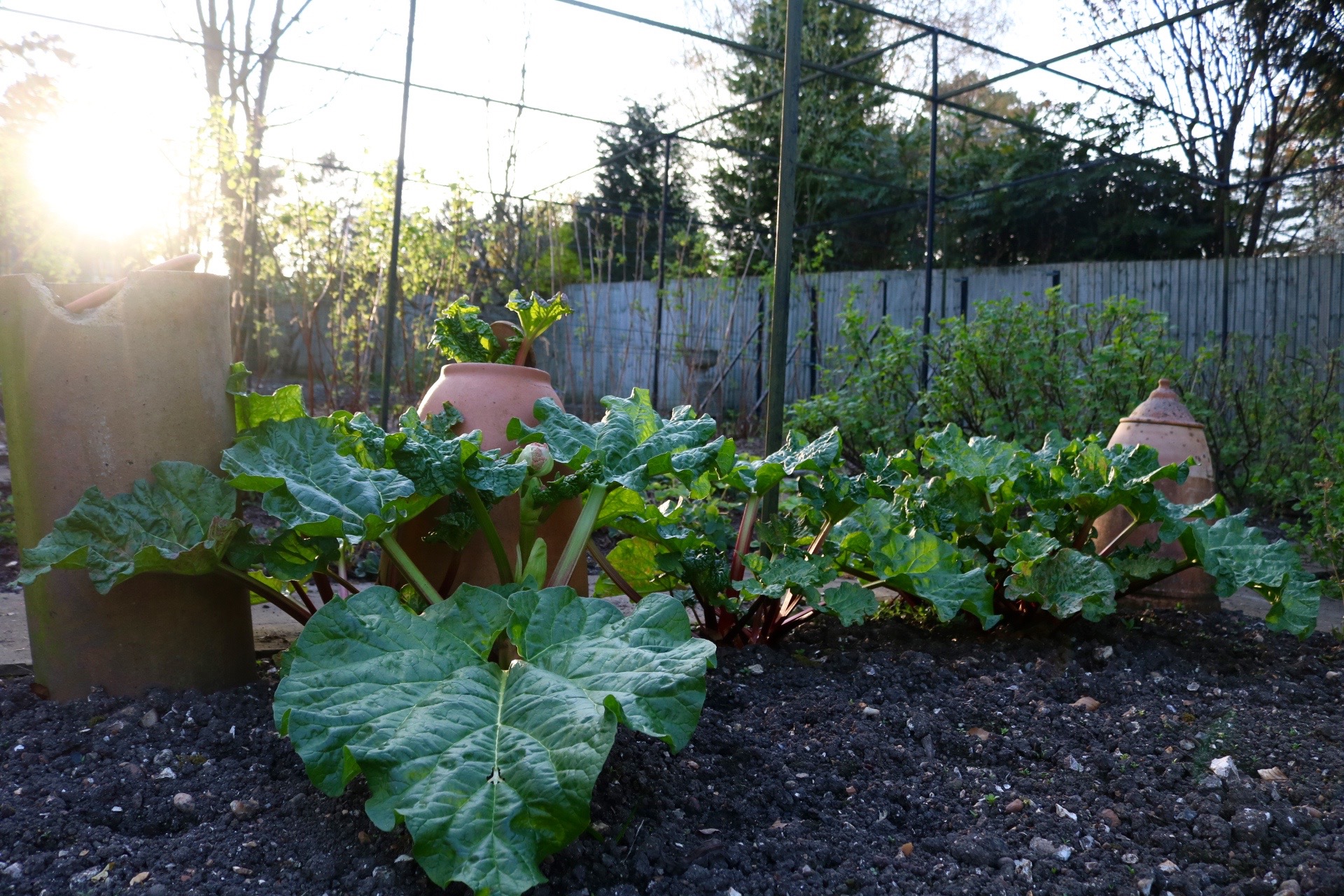
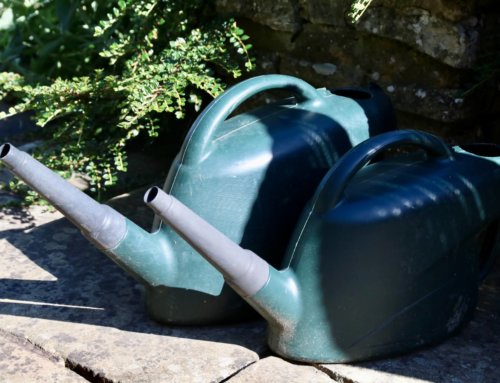
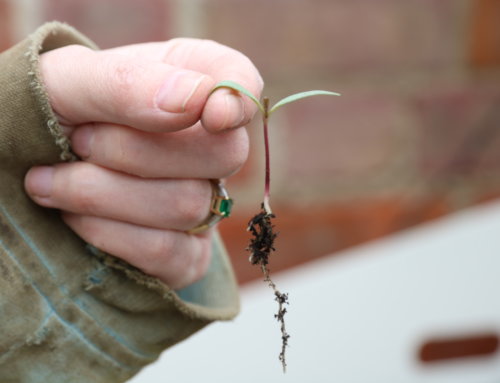
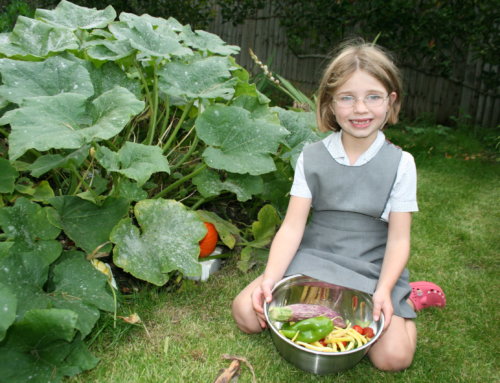
Dont suppose you’d like to be an aunt to another neighbour..a chip off the old block sounds a good place for me to start!
I think I can definitely spare some. I’m also going to buy some new crowns this year as I lost one from forcing two years in a row by mistake! I think I need a system like the Lost Gardens of Heligan!
What is the reason for not picking rhubarb the first year?
It needs to have a chance to get established first. The plant uses its leaves to feed itself and therefore to grow. If you take some of its stems and leaves away this will reduce its ability to grow. A very strong, large new plant could maybe cope with a small harvest in the first year but generally new plants should be given a bit more time before picking. It’ll be worth the wait though!
Thank you for writing this article. My friend gave me a teeny rhubarb plant in May. I only became interested in growing fruit, veg and plants this year. The rhubarb is doing well. This is the best informative article I have read regarding rhubarb care. Hopefully I will harvest luscious stalks next year 😋.
Hi Ronnie, what a fabulous gift from a friend. Good luck for next year – I hope you have lots of tasty stalks from it.
Thank you for your excellent article. Gives me hope that mine isn’t dying.
His is brilliant as we are thinking about getting Rhubarb at the moment.All we need on your page Thanks so much for sharing x
My pleasure, Caroline. Best of luck with your rhubarb and wishing you many years of delicious crumbles.
Thanks Katherine 🌱
I have huge leaves and thick rhubarb but it doesn’t seem to want to turn red. Any ideas
Hi Michael, Is it in a shady place? Whilst red rhubarb is pretty I find the green bits of stalk tasty too!
Hi Michael. The green stalks taste just as good but the ruby red is of course more attractive. I think that a sunny spot helps with the colouring and apparently also the soil ph as it prefers less acidic soils. Go ahead and cook it anyway. I’m sure it’ll taste good.
I bought a crown in a garden centre in April and put it in a large pot as we have a very small low maintenance garden. It didn’t do anything for several weeks and then it sparked into life and currently has about 6 stalks on it. Should I pick them or leave them as it’s a baby plant, and if I pick them when is the best time please, thanks
It’s probably best in the first year to let it build up a bit. Having said that I think I would be tempted to pick a couple of stalks just to see how they tasted!
Our rhubarb is still looking healthy with long stalks and huge leaves but is it safe to eat in September?
Yes it’s safe. Mine tend to collapse once the nights draw in but if they’re still going strong then go for it. I’m assuming you’re cooking something tasty – wishing you a yummy dish!
If I put my new terracotta orcer our now – mid March – is it likely to crack in frost?
Hi Fran, now is the time to put in over the rhubarb if you want to force it. Much later and you’d miss the boat. Forcers do crack when they’ve got very wet and then it gets very cold but unless we get a very cold spell indeed it should be fine. Hope you get to eat lots of tasty rhubarb.
If you don’t pull the rhubarb the first year when do you take all the rhubarb for the the winter
If some of the rhubarb looks a bit limp after planting do you pull them out
Hi Gordon, The first year I didn’t pull any of the rhubarb even as winter approached. I just let it die back. I guess you could see what state they’re in as you head into autumn and eat them but I find they die back pretty quickly in autumn. Again, first year I’d leave the weedier stems on the plant to photosynthesise and build up energy for the roots. If something is so limp it collapses then this could be removed.
Hi my Rubarb is coming into it’s 2 year the leaves are huge but the stalks aren’t red are there different kinds of rubarb?
Hi Nancy, there are different cultivars available and some are more green than others. It shouldn’t affect the flavour though. I hope you try it and that you like the taste!
My plant is in second year, growing rapidly. Have many stalks, but thin ( not wide thick stalks). Do I need to thin out?
Hi Jane, my view is that I’m growing it to eat so I would definitely harvest some of the stalks and enjoy eating them. Hopefully as the plant grows in strength the stalks will get thicker over the years.
Hi,
Had a decent crop from my 2 crowns which are 2 years old this year. The leaves died down in September, but now I see the plants are sprouting again in early October here in Hertfordshire. Should I just leave them to die back or pull the leaves abs small stalks?
Hi Laurence, I would leave them now unless you’re desperate for a crumble. They’ll be back next year.
Hello. I have some very large established crowns that I’m moving from my allotment to my garden. Will I still need to leave them to get established for a year? Or shall I just see what happens and harvest if it looks strong? Sunny position. Gravelly soil.
Hi Matt, Apologies for the delay in responding. If they’re large healthy crowns and generate lots of stalks then there will be no harm in harvesting some. Be guided by how the plant responds to the move.
Hi Katharine,
Found your article on rhubarb most helpful. , thank you. Have just recently moved house and found we have some rhubarb on the corner of the flower bed starting to sprout. Was trying to find some information on ‘forcing’ rhubarb and as we bought a spare chimney pot with us from our previous house I will use this , thanks to reading your article. I seem to remember my Dad placing a bucket over rhubarb when I was a youngster. I am not sure how long the rhubarb has been established though?
When should rhubarb be oncovered please?
Do you mean if you’ve forced it? If so, uncover it when you want to harvest and eat it.
Can you tell the age of a plant? I moved into a new home in November and I have two huge plants in the backyard. I’m guessing they’d be harvestable if they’re big like that? Before it got huge leaves there were at least 6 red bulbs seen.
Hi Karen, I’m not sure how to age a plant but yes, if it’s obviously large then it will be a few years old and you should harvest those delicious stalks
Hi, I’m using a terracotta forcer for the first time, and the rhubarb is now ready to pick. Do I only get the one picking or do I continue using the forcer for a while this season? If so, how many pickings could I do without harming the long term health of the plant?
You only really get one picking of forced rhubarb. Once picked, leave the forcer off for the plant to recover for next year and don’t force the same plant every year. Those tender stems are worth it though!